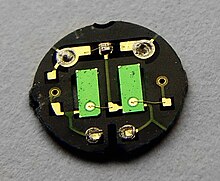Pyroelectricity
Pyroelectricity (Greek. Pyrein , πυρος pyro = "burn, I burn," also: pyroelectric effect , pyroelectric polarization ) is the property of some piezoelectric crystals to a temperature change Δ, T with charge separation to respond. Pyroelectricity occurs only in the following ten crystal classes: 1, m , 2, mm 2, 3, 3 m , 4, 4 mm , 6 and 6 mm .
root cause
In pyroelectric crystals are polar crystals . That means they have a permanent electric dipole . They are therefore made up of electrically polar unit cells, each of which has its own dipole. In contrast to ferroelectric crystals, in which the direction of polarization can be influenced by applying an electrical voltage , all electrical dipoles in pyroelectric crystals have the same direction. A pyroelectric crystal is therefore always piezoelectric when it is deformed, i.e. it generates an electrical voltage .
If you heat or cool a pyroelectric crystal, the opposite surfaces are electrically charged in opposite directions, whereby the end that charges itself positively when heated is called the analog pole , the other is called the antilog pole . The resulting voltage difference can be tapped at the corresponding crystal edges (surfaces) with electrodes .
The polarization is :
where is the pyroelectric constant and the temperature difference.
The existing surface charges are, however, compensated by charge carriers absorbed from the environment, e.g. B. free electrons . Therefore, (Apparent) surface charges occur only at a change of temperature on. In contrast, with a thermoelectric material, a temperature difference between two sides of a workpiece results in a constant voltage.
The change in temperature of a pyroelectric crystal causes a change in the spacing of the lattice ions. On the one hand, this causes a change in length ( thermal expansion ) in the crystal axis , the direction of which corresponds to the direction of polarization. According to the piezoelectricity, this creates a charge. On the other hand, the permanent polarization changes with temperature. Both effects are in the same direction and lead to an external charge of the crystal.
The pyroelectric effect was first found in tourmaline . The reverse of this effect is the electrocaloric effect ; H. the generation of heat (cold) when an electric field is applied (collapsed).
A distinction is made between two forms of the pyroelectric effect:
- Real pyroelectric effect (real pyroelectric effect): Based on a grid remodeling when the temperature changes. It is identified by the coefficient .
- Wrong pyroelectric effect (pseudopyro effect): Here the crystal changes its volume depending on the temperature and thus the charge-volume ratio. It is marked with the coefficient .
In summary with the equation mentioned above, this results in:
- With
whereby often predominates.
Examples
In addition to tourmaline, other materials also show this effect, including triglycine sulfate (TGS), often in deuterated form (DTGS), sometimes doped with L- alanine (LATGS, DLaTGS), lithium tantalate or polyvinylidene fluoride (PVDF).
Other pyroelectric materials are:
- Tourmaline group minerals
- Strontium barium niobate (SrBaNbO 3 )
- Lead titanate (PbTiO 3 )
- Barium titanate (BaTiO 3 ) in the ferroelectric state, i.e. H. below the ferroelectric Curie temperature, because the material must have spontaneous polarization.
- Sodium nitrite (NaNO 2 )
- Lithium niobate (LiNbO 3 )
- A pyroelectric effect can also be observed on bones and tendons
proof
For a qualitative proof, a crystal is briefly immersed in liquid nitrogen. It is then observed how ice condenses on the cold crystal from the moisture in the surrounding air. When charges on the surface have been shifted, thread-like ice particles form, which follow the electric field lines .
application
Pyroelectricity is mainly used in sensor technology . Infrared ( motion detectors , fire alarms ) and microwave detectors , temperature sensors ( temperature sensors ) and calorimeters are based on this effect. Even very small changes in temperature create an electrical voltage. As a result, passive infrared motion detectors, for example, can react to the movement of living beings when they are still several meters away.
With such pyroelectric crystals, very high voltages of several 100 kV can be generated with simple means in a small space.
Another application is very small X-ray sources the size of a matchbox, where electrons are accelerated by the field of the pyroelectric crystal.
Pyroelectric crystals are also used for the sensitive detection of THz radiation down to the picowatt range.
Individual evidence
- ^ Richard JD Tilley: Crystals and Crystal Structures . John Wiley & Sons, 2006, pp. 82 ( limited preview in Google Book search).
- ^ Will Kleber , Hans-Joachim Bautsch , Joachim Bohm : Introduction to Crystallography. Verlag Technik, 1990, ISBN 3-341-00479-3 , p. 262.
literature
- Karl Nitzsche, Hans-Jürgen Ullrich (ed.): Functional materials in electrical engineering and electronics . 2nd heavily revised edition. German publishing house for basic industry, Leipzig et al. 1993, ISBN 3-342-00524-6 .
- Hanno Schaumburg: sensors . Teubner, Stuttgart 1992, ISBN 3-519-06125-2 ( materials and components of electrical engineering 3).








